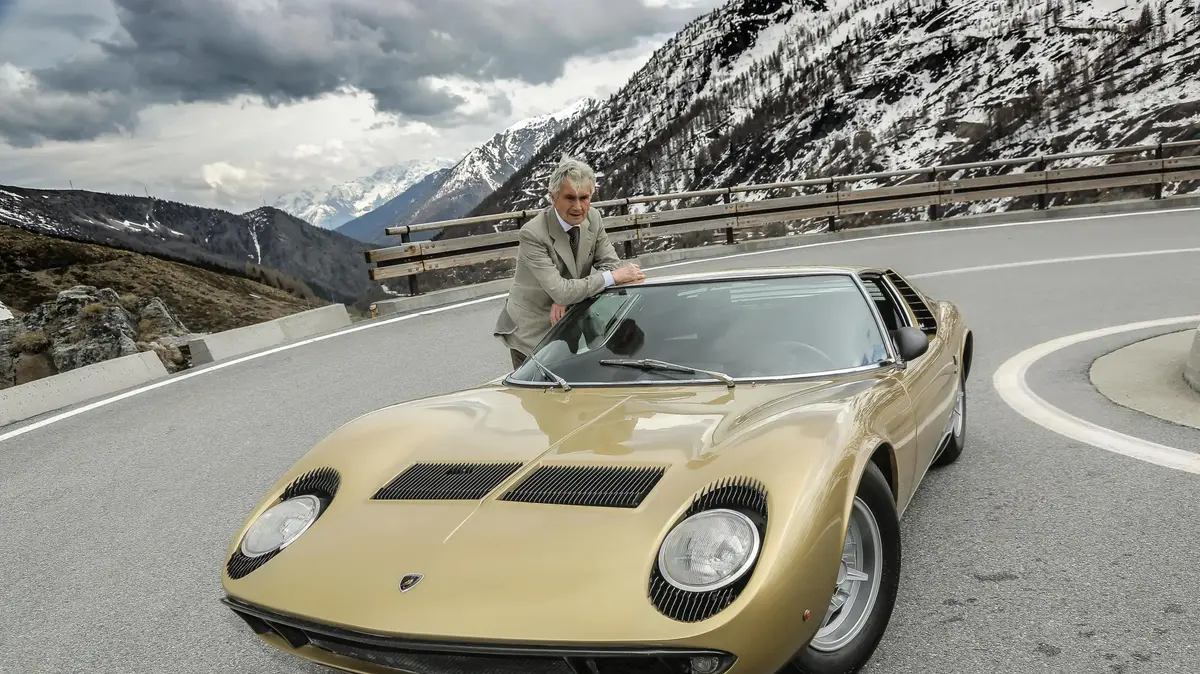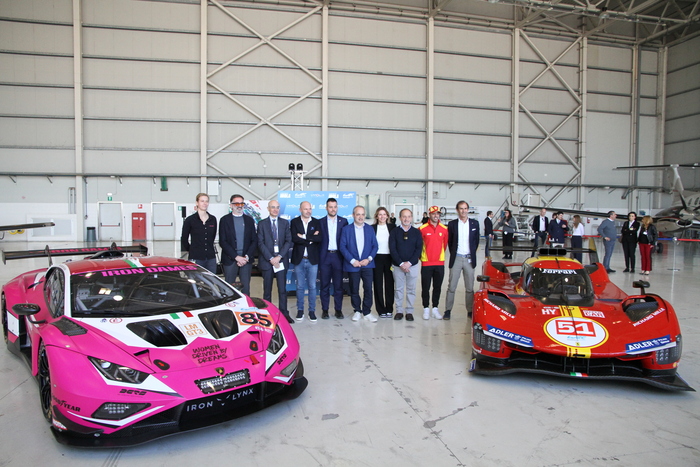Giotto Bizzarini in the 60s (Photo: User Photos, from Wikipedia, source unknown)
In a motor world that is constantly innovating, where today's highlight is tomorrow's history, very few people manage to leave a fingerprint that remains clear for years, decades. That cars that came out 71 years ago and still resonate, accelerate heart palpitations and put hairs on the back of the neck. But that's only a small part, a narrow angle of the man the world said goodbye to today at the age of 96, just before his birthday - the story of Giotto Bizzarini, the engineer who breathed life and soul into machines.
Giotto was born in Livorno, Italy, to a family where invention and innovation pervade her like a thick Bolognese sauce. He is named after his grandfather who worked alongside Guglielmo Marconi on discoveries in the field of information transmission via radio waves in the early 20th century.
Grandson Giotto was not interested in what's in the air, but in what's on the ground, and he concludes his engineering studies in 1953 with a project of his own in the form of turning his modest Fiat Topolino into a sports car with an improved engine, chassis and body.
A year later he comes to work at Alfa Romeo, and to his disappointment is appointed to the development team of the Giulietta chassis, his goal was not what was under the car, but what was in front of it - the engine. He gets there through Alfa Romeo's experimental and development department. But he did not limit himself to leaning behind drawing boards, but also served as the manufacturer's test driver: "I became a test driver who also happened to be an engineer, with mathematical principles. I always needed to know why something went wrong so I could find a solution for it."
The first job in Alfa Romeo with the Giulietta Berlina (Photo: manufacturer's website)
His experience as a test driver was also his ticket to the next stop in his career – at Ferrari, which he joined in 1957. There he advances to the head of the experimental department for the development of sports cars and GT. During his 5-year career with Enzo Ferrari as Chief Engineer, he touches on legends that have grown into the 250 model family, with names like the 250GT and the original Testa Rossa with the 3-litre V12 engine.
But the jewel in the crown, the one that glitters to this day was the 250 1962 GTO, a car in which Ferrari applied the most advanced aerodynamic principles of its time to create a car for GT racing and was supposed to provide the aerodynamic envelope for the car it was based on, the 250 with a short wheelbase.
For the experiments and development of the prototype, Bizzarini donates his 250 GT on which the experimental body was worn and in which technical changes were made such as moving the engine backwards and down as much as possible, equipping it with dry oil stress, extending the bow. Giotto once said that they called the car "the monster," but the rest of the factory simply knew it as "Bizzarini's ugly duckling." Keep children away from the screen and Google pictures il mostro bizzarrini and decide for yourself who was right.
More in Walla!
Beat the Pain: B-Cure Laser in an Unprecedented Experience
Contributed by B-Cure Laser
A Ferrari 250 GTO, one recently sold for $48 million, Bizzarini even got to launch it himself (Photo: manufacturer's website)
By the way, this car, in which he invested so much, he did not get to launch himself, a year before it went on the market, he was one of the five engineers and three senior managers at Ferrari who were ousted in the so-called "Night of the Long Knives" at the company.
The eight were concerned about what they saw as the over-interference of Laura, Enzo's wife, in the company's affairs, and they expressed their protest through the day of the company's departure including a letter from a lawyer articulating their claims. Lanzo, who had enough that the suit wouldn't sit well enough on you to make ends meet, brought the clause twice - he accused them of trying to start their own company and, as mentioned, ousted them.
Well, visionary or not, he wasn't completely wrong, because after this departure Giotto and Carlo Gitti set out to form Automobili Torismo a Sport, or ATS for short. To say that there was great success there? Not really - in 1964 they close the stall, Gitti goes to develop for Alfa Romeo the Tipo 33 Stadarella (probably the most beautiful race car in history) while Bizzarini starts a company that bore his name, enters into a partnership with the motorcycle manufacturer ISO that aspired to develop into the world of sports cars and parted ways with it due to disagreements, he continues to engage in various projects, one of which is the one that will become the second anchor of his illustrious career - the V12 engine for the Lamborghini 350GT.
Ferruccio Lamborghini. You don't want to upset a Taurus, you don't want to upset an Italian – he was both.
Like Giotto, Procchio Lamborghini, a wealthy tractor manufacturer from northern Italy, had an open account with Enzo Ferrari - the story is known - he offered Ferrari a solution to the transmission synchronization mechanism, the latter dismissed him by saying that he would continue to build tractors and leave it to those who understand sports cars to produce them and the rest is history, because there are two things you don't want to upset - Italian and Taurus - Ferruccio was both...
He enlists Bizzarini to build an engine like no other, the guiding principles - a V12 configuration, a displacement of 3.5 litres and as much hp as possible, at least 350. I also considered the next story a legend, until a few years ago I found it certified in the Lamborghini archives, and the story goes like this - to incentivize Bizzarini to get as much power out of the engine as possible, Lamborghini tells him that in addition to the regular payment, he will also receive a bonus for every 10 horses above that number.
Introduced in 1963, it survived in various incarnations until 2010 - Bizzarini's V12 engine in Lamborghini (Photo: manufacturer's website)
In July 1963 the first run of the engine takes place, the results are fantastic - 360 hp some say 370, Ferruccio, a man of honor pays Bizzarini the amount plus the bonus, only there is a catch - for this power the engine reaches 9,000 rpm - meaning it is nothing less than a racing engine, but meant to serve a road car, a leisurely GT car. But a word is a word. This engine not only served the 350GT eventually with a milder calibration - 280 bhp at 6,500 rpm and up to 320 bhp in the later yearbooks - it became an iron sheep asset in Lamborghini, every Lamborghini that was worth anything until 2010 used the base of this engine; From Yora, Islero, Espada, Countach, LM002, Diablo, to the edge version of the Morchilago, the SV there is already a 6.4-liter wild animal with 670 hp.
Italdesign and Bizzarini's MANTA catapulted the design house to consciousness (Photo: manufacturer's website)
The next significant milestone in his career was the launch of the design house "Italdesign" by car designer Giugerto Giugiaro, one who signed on to some car called the first-generation Volkswagen Golf, I don't know if you've heard of it.
The MANTA prototype car presented by the two at the 1968 Turin Motor Show was responsible, among other things, for catapulting this design house into world consciousness. Over the years, and especially in the 60s, while building a reputation as a master of engine and engineering sports cars, Bizzarini never abandoned his true dream - a sports car that would bear his name. But apparently what worked very well for him under a broader framework was less successful for him when he did it himself.
Bizarini 5300 GT, finally a car with his name on it (Photo: manufacturer's website)
The Bizzarini P538, later called the 5300 GT, which bore his name and was introduced in 1964, did not become as legendary as the dreams it had been signed to over the years. Not that it wasn't a good car, it was a sports car built in a coupe or roadster configuration for the public road (Strada) as well as a track version (Corsa), and in it the engine was not his, but Chevrolet's "small block", a 8.5-liter V3 with 365 hp on a car that weighed 1,200 kg, and 400 hp for the track version that weighed even less.
So yes, it wasn't a financial success, but before he rolled the drawing sheets and shelved this company, he saw it take first place in its category in the 24 1965 Hours of Le Mans (and 9th overall!). In 2021, this car seemed to be getting its historic honor, when one of the few Corsa cars sold at auction for $425,<>.
The Corsa version of the racetracks. A huge achievement of winning in its category at Le Mans (Photo: manufacturer's website)
From the 70s he went on to a consulting career in the automotive world, the era of cars he loved to design and build seemed to disappear under the fuel crisis of 1973, of air pollution regulations, of moving away from the carved chariots of the gods of those years, the people who paid a lot of money for cars had a kind of expectation that they would also move whenever they wanted to drive them. He has been involved in projects for American Motors with the AMX, for General Motors, motorcycle manufacturers, and with Bean Design Pininfarina. Until the second decade of the 2000s, he was still teaching and directing engineering projects at the University of Rome.
The modern incarnation, anyone who knows anything about his whereabouts, please report to the authorities (Photo: manufacturer's website)
In 2006, a bizarre partnership between the Thai company Arbitrage and Cobra Engineering is announced: illustrations of a car called the Bizzarini P538, with an exotic list of materials, a spectacular design that was also approved by Giotto himself, and again the use of a Chevrolet engine - this time a 8.7-liter V0. As far as is known, this project survived the construction of 4 prototype copies before it was shelved.
So Giotto Bizzarini is gone, probably now settling scores with Enzo and Procchio, or planning the next sports car that will amaze the angels, because with us humans he has absolutely succeeded. Go to the cupboard, pull out your best bottle of Chianti and pour one beautiful glass in memory of the last Nephilim.
- Car
- Car News
Tags
- Italy
- alpha
- Alfa Romeo
- Lamborghini
- Ferrari
- Sports cars







